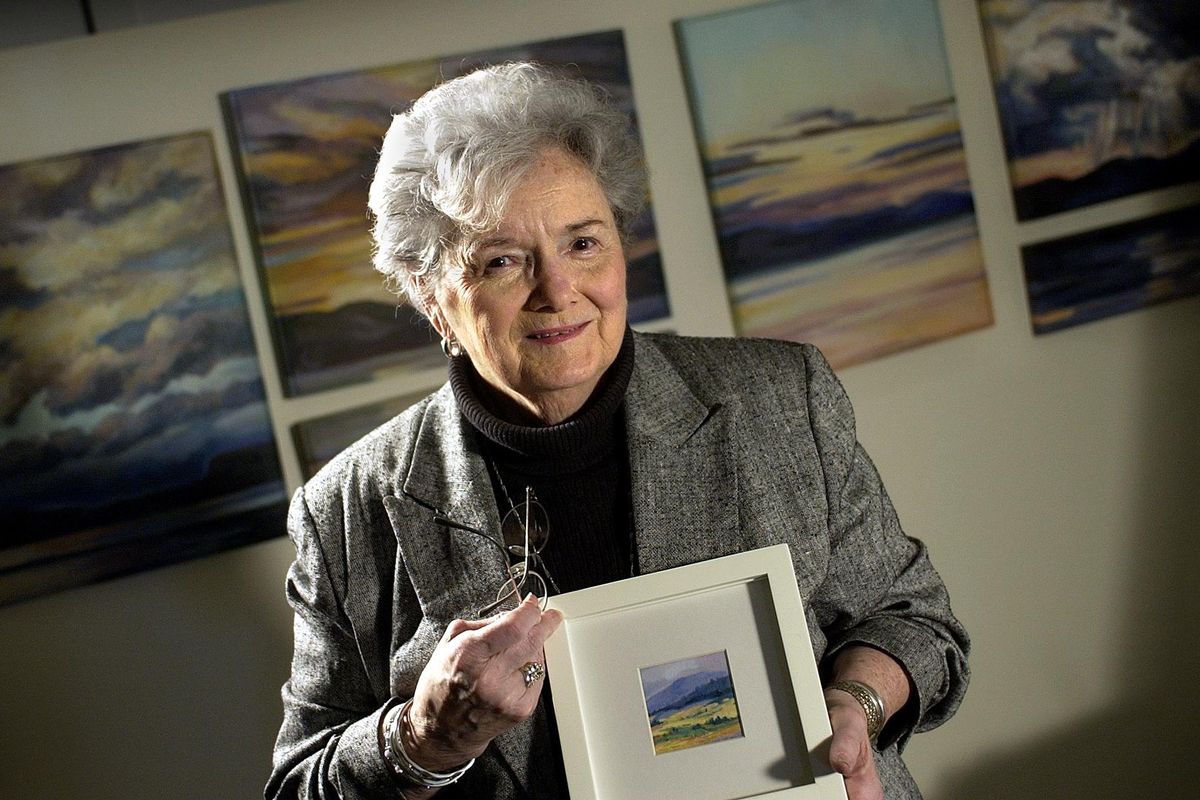Chase Gallery exhibit details the behind-the-scene work of late artist Pauline Haas

“Haas Collected,” at the Chase Gallery in the lower level of Spokane City Hall, is a deeply personal, and extremely joyful, journey into the mind of one of Spokane’s most beloved artists and teachers, the late Pauline Haas, who died last year.
It’s also the most difficult exhibit that Spokane Arts Interim Director Ellen Picken has ever mounted at the gallery. “Because of the sheer amount,” she said.
Packed into the space are more than 70 pencil drawings, ink sketches, oil paintings, pastels and tattered journals. Most pieces are unfinished and unframed, some even showing wrinkles and water damage, most are affixed to the walls by tacks. Many are for sale for the holiday season.
The works taken together reveal an intense and lively inner conversation that Haas had with herself as an artist. It’s an intimate observation of a prolific painter’s processes and styles that her former students might recognize, and that all artists can appreciate.
Haas, who retired in 1985 from the Whitworth University faculty after teaching art for more than 20 years, never stopped working and creating up until her death on Aug. 14, 2015, at age 91.
Haas’ exhibit in Whitworth’s Oliver Gallery in 2013 ,in celebration of her 90th birthday, featured her current artworks, rather than being a retrospective.
What makes the Chase exhibit so personal – and fascinating – is that this collection was never meant to see the light of day. They were the practice exercises, the unfinished portraits and landscapes, the first and second drafts, left in piles on Haas’ studio floors and shelves. After she died, Haas’ only daughter, Judy McKeehan, stored them in a basement closet, unsure of what to do with them.
“It seemed such a shame to me that no one else would ever see them,” said McKeehan, a local watercolor artist. McKeehan said she finally picked up the phone and called the first place she thought of, the Chase Gallery, which is run by the Spokane Arts Commission. Chase curator Picken had heard how significant Haas was to the lives of the many local and regional artists who studied or worked with her during her lifetime, and was immediately intrigued.
Picken arranged to meet at McKeehan’s house in Cheney to start digging through the basement. “Within a few minutes I was like, ‘Oh yeah, there’s waaaay more than enough to show,’” Picken said.
The exhibit provides insight into how an artist creates and experiments, the stages she puts herself through before final production of a finished work. There are quick drawings of nude models, the kind of exercise Haas might have used to loosen up her wrists or simply have fun. There are sketches with more refined strokes in pencil, next to charcoal renditions of the human form with yet more defined contours and lines. Her command of her tools is highlighted in her penciled landscapes filled with roiling clouds.
One wall of mostly oil paintings reveals an artist not shy of color, with deep purples jumping from the canvases. The vibrancy is in the air, surrounding the plants, in every little leaf and shadow. “It makes me wish I’d known her,” Picken said.
Even more of Haas’ personality comes through on the pages of several travel journals displayed in plexiglass, with titles like “Semester at Sea – Ports and People.” Haas used a blue ballpoint pen to record fellow travelers and performers she observed – waiting, eating, or dancing – on her many mission and school trips.
“If she didn’t have a sketchbook with her she would sit and pretend she was sketching on her knee, or inside her pocket, with her finger,” McKeehan said. “It was a good addiction.”
The only truly consistent theme of the show is Haas’ changing styles.
“Every one of these pieces is different, like you’ll see this ink drawing of a man, almost like a cartoon that’s probably a quick, live drawing of one of her friends,” Picken said. “Then you see this portrait in green and blue pastels, which is very finished, with a sketchy stylized stroke to it, that shows how she was deeply experimenting in this completely different style.”
McKeehan said she is gratified by the final choices and arrangements of her mother’s collected works-in-progress at the Chase. “I had no expectations or any idea on how to approach anything,” McKeehan said. “I was just blown away that it was so great.”